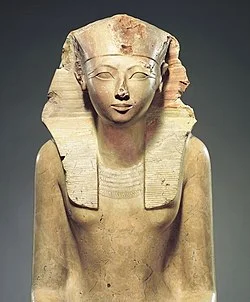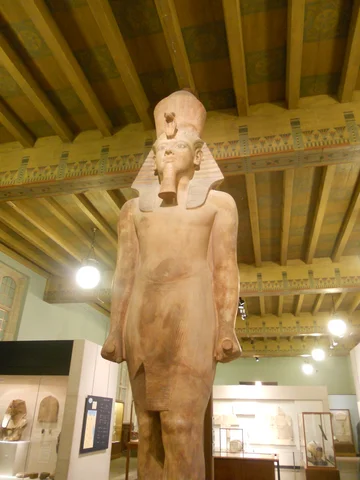-
Characteristics: Military expansions, Diplomacy, Foreign influence and power, and Cultural dynamism. Dr. Amy Calvert, "New Kingdom and Third Intermediate Period, an introduction," in Smarthistory, February 14, 2022, accessed October 2, 2025, https://smarthistory.org/new-kingdom-third-intermediate-period-introduction/.
-
 The sculpture of Hatshepsut represents a powerful pharaoh wearing the nemes headdress and it is a symbol of divine spiritual wisdom. Artwork source citation: New kingdom Egypt. Dynasty 18. Hatshepsut. c.1473-1458 BCE. Metropolitan Museum of Art, NYC, Limestone, 84" ht. source: Dr. Beth Harris and Dr. Steven Zucker, "Mortuary Temple and Large Kneeling Statue of Hatshepsut," in Smarthistory, August 9, 2015, accessed October 2, 2025, https://smarthistory.org/hatshepsut/.
The sculpture of Hatshepsut represents a powerful pharaoh wearing the nemes headdress and it is a symbol of divine spiritual wisdom. Artwork source citation: New kingdom Egypt. Dynasty 18. Hatshepsut. c.1473-1458 BCE. Metropolitan Museum of Art, NYC, Limestone, 84" ht. source: Dr. Beth Harris and Dr. Steven Zucker, "Mortuary Temple and Large Kneeling Statue of Hatshepsut," in Smarthistory, August 9, 2015, accessed October 2, 2025, https://smarthistory.org/hatshepsut/. -
 The Akhenaten, Neferiti and the royal princesses Aten, the Solar Disk, blessing the royal family symbolizes divine blessing and connection between the family. Artwork citation: New kingdom Egypt. The Akhenaten, Nerfeiti and the royal princesses Aten, the Solar Disk, blessing the royal family. c. 1350 B.C.E, Limestone, Carving.
The Akhenaten, Neferiti and the royal princesses Aten, the Solar Disk, blessing the royal family symbolizes divine blessing and connection between the family. Artwork citation: New kingdom Egypt. The Akhenaten, Nerfeiti and the royal princesses Aten, the Solar Disk, blessing the royal family. c. 1350 B.C.E, Limestone, Carving. -
 The King Tutankhamun sculpture represents an Egyptian pharaoh, seen wearing the nemes headdress, or the crown of upper and lower Egypt, symbolizing that he ruled over all of Egypt. Artwork Citation: Egypt New Kingdom, King Tutankhamun. c. 1332-1323 BCE. Limestone, 20' ht. Center for the Study of Ancient Cultures, U of Chicago, Hyde Park.
The King Tutankhamun sculpture represents an Egyptian pharaoh, seen wearing the nemes headdress, or the crown of upper and lower Egypt, symbolizing that he ruled over all of Egypt. Artwork Citation: Egypt New Kingdom, King Tutankhamun. c. 1332-1323 BCE. Limestone, 20' ht. Center for the Study of Ancient Cultures, U of Chicago, Hyde Park.
